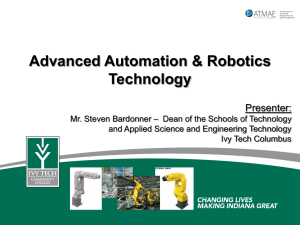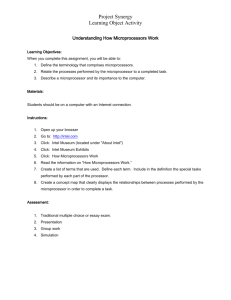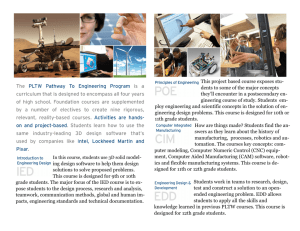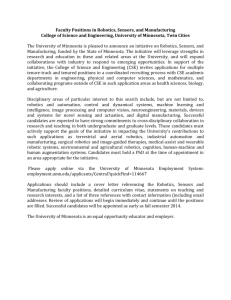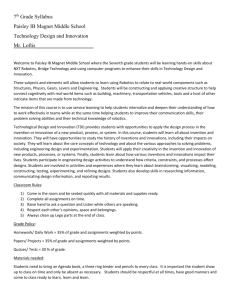Example scheme of work
advertisement
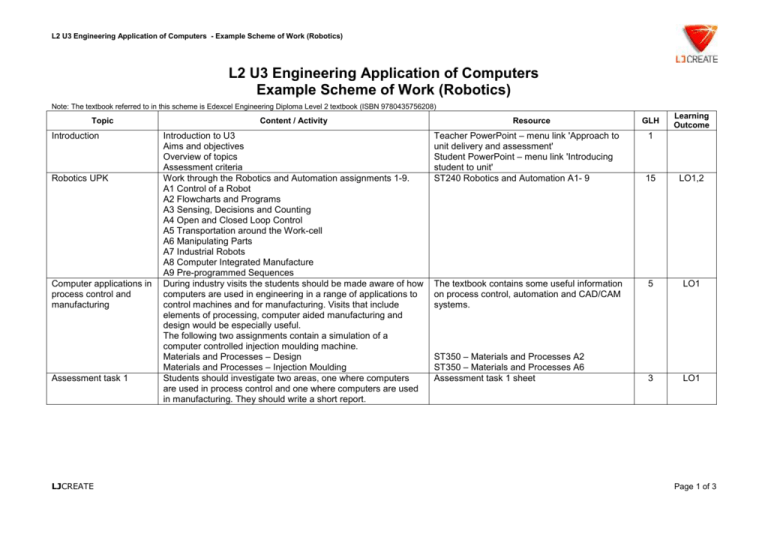
L2 U3 Engineering Application of Computers - Example Scheme of Work (Robotics) L2 U3 Engineering Application of Computers Example Scheme of Work (Robotics) Note: The textbook referred to in this scheme is Edexcel Engineering Diploma Level 2 textbook (ISBN 9780435756208) Topic Introduction Robotics UPK Computer applications in process control and manufacturing Assessment task 1 LJCREATE Content / Activity Introduction to U3 Aims and objectives Overview of topics Assessment criteria Work through the Robotics and Automation assignments 1-9. A1 Control of a Robot A2 Flowcharts and Programs A3 Sensing, Decisions and Counting A4 Open and Closed Loop Control A5 Transportation around the Work-cell A6 Manipulating Parts A7 Industrial Robots A8 Computer Integrated Manufacture A9 Pre-programmed Sequences During industry visits the students should be made aware of how computers are used in engineering in a range of applications to control machines and for manufacturing. Visits that include elements of processing, computer aided manufacturing and design would be especially useful. The following two assignments contain a simulation of a computer controlled injection moulding machine. Materials and Processes – Design Materials and Processes – Injection Moulding Students should investigate two areas, one where computers are used in process control and one where computers are used in manufacturing. They should write a short report. Resource Teacher PowerPoint – menu link 'Approach to unit delivery and assessment' Student PowerPoint – menu link 'Introducing student to unit' ST240 Robotics and Automation A1- 9 The textbook contains some useful information on process control, automation and CAD/CAM systems. ST350 – Materials and Processes A2 ST350 – Materials and Processes A6 Assessment task 1 sheet GLH Learning Outcome 1 15 LO1,2 5 LO1 3 LO1 Page 1 of 3 L2 U3 Engineering Application of Computers - Example Scheme of Work (Robotics) Assessment task 2 Students set up and program a computer linked to a Robot system. They should write a short report. Microprocessor applications in everyday consumer products. Students have to explore how microprocessors are used in engineered products and in particular everyday consumer products. A presentation introducing students to how a microprocessor is used to control a microwave oven could be used. Assessment task 3 LJCREATE Assessment task 2 sheet and brief. Two different briefs (Brief A and Brief B) have been produced based on students using the robot to either control an industrial system or to move nuclear fuel rods. Solution programs are included in the support documents for the teacher to see what students are expected to produce. Three levels of complexity are provided for Brief A. (Brief A has been created using the ST240 Robotics and Automation module A10 Automated Nuclear Work-cell. Brief B has been created using the ST240 Robotics and Automation module A8, Assembling Parts activity.) The textbook contains some useful information on microprocessors and their use in domestic appliances. A presentation giving students an introduction the basic theory and components of a microprocessor system could be used. Microprocessor Control of a Microwave Oven PowerPoint is included in the support documents section Introduction to Microprocessors PowerPoint is included in the support documents section A good practical introduction to the use of microprocessors would be to work through the following assignments: Electronic Circuits – LED Lamp Circuit Electronic Circuits – Flashing Door Bell Electronic Circuits – Road Crossing Controller This could be carried out as a small project and will result in students building a PIC based microprocessor system. ST450 – Electronic Circuits A3 ST450 – Electronic Circuits A10 ST450 – Electronic Circuits A15 Note: A3 and A10 are needed for students to complete A15. Students can carry out research on how microprocessors are used in a range of consumer devices, such as DVD players, toasters, digital alarm clocks etc… The “how stuff works” website contains a wealth of information on how consumer devices work. Students should investigate the use of microprocessors in two consumer products and write a short report. Assessment task 3 sheet 6 10 LO3 5 LO3 Page 2 of 3 L2 U3 Engineering Application of Computers - Example Scheme of Work (Robotics) Computer aided technology in maintenance operations. Students should investigate how computer technology is used in engineering for maintenance tasks. A presentation introducing students to how computers are used in the maintenance of engineering products could be used. Activities where students learn about using computers for maintenance could be linked to the car or transport industry: * Service schedules * Diagnostic testing of vehicles * Downloading data from engine management systems * Monitoring performance in racing cars * Real-time aircraft monitoring systems in modern airliners. Students could collect examples of diagnostic or maintenance printouts during industry visits. A visit to an automotive garage with a focus on diagnostics would be a good opportunity for students to see this in action. Assessment task 4 LJCREATE Students identify two different situations where a computer system is used to carry out or assist a maintenance procedure. Students also have to use a computer print out to diagnose a fault and decide a course of action. The textbook contains some useful information on vehicle diagnostics, hand held computers and vision systems. Use of Computer Technology in Maintenance PowerPoint is included in the support documents section 10 LO4 5 LO4 Both the Boeing and the Airbus websites have information on their real-time aircraft monitoring systems. Students can research OBD and EOBD on the internet. This is the standard used for motor vehicle diagnostics. An example service schedule and report from a computer based exhaust emissions test is included in the support documents. Assessment task 4 sheet and the computer data for fault finding Page 3 of 3
